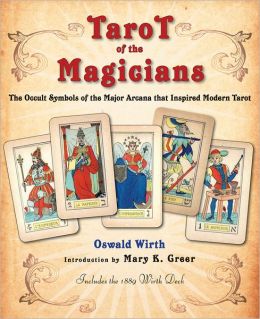
This is a special new edition of Oswald Wirth’s classic tarot book that was first published in 1927. Wirth (pronounced “veert”) was a prominent figure in the late 19th-early 20th century occult movement. He was a co-founder of the French mystical Kabbalistic Order of the Rosy Cross (aka the Rosicrucians), a group distinct from the British Order of the Golden Dawn. The French and English occult groups of this period developed different systems of tarot attributions that persist to this day. The Golden Dawn material is more familiar and commonly used by American tarotists. This timely reprint provides a chance to see how tarotists work on the other side of the Channel.
Mary Greer provides biographical information about Oswald Wirth (born 1860) in her introduction. The Swiss-born Wirth moved to Paris when he was twenty. He joined the Freemasons and became interested in hypnotism, healing, and occultism. Wirth became the friend of Stanislas de Guaita, who instructed him in the occult. Wirth and de Guaita designed the “22 Arcana of the Kabbalistic Tarot” based on the earlier work of Eliphas Levi (1804-1875). These were published in 1889.
After de Guaita died in 1897, Wirth took a civil service job in a library. He continued to write and publish material for the French Freemasons, and linked the esoteric Kabbalistic symbolism of the Tarot to Masonic knowledge. Wirth designed a new version of his deck in 1926, followed by “Le Tarot des Imagiers du Moyen Age” (Tarot of the Medieval Image-Makers) in 1927. Following the precepts of his friend de Guaita, Wirth's intention was to “restore the purity of the Tarot.” (pg. ix)
Wirth's writings espouse an older set of esoteric ideals that may be unfamiliar to contemporary tarotists. The goal of spiritual illumination is the same, but Wirth's esoteric transcendentalism is distinct from New Age teachings and pagan-earth spirituality. Wirth's core ideas are derived from Eliphas Levi's transcendental magic and classical Hermeticism. He regards the twenty-two Major Arcana cards as a code book for the secret esoteric path to developing the pure, focused will of the Magician.
In Part I: The Tarot, Wirth gives a bit of tarot history that includes remarks about Levi, Paul Christian, and Etteilla – all French mystics and authors. He goes on to discuss the structure of the Major Arcana, and arranges the cards in different ways to demonstrate alternative groupings and relationships between the trumps. He integrates numerology, the Sephiroth, constellations (some non-zodiacal star figures are used), aspects of Pythagorean geometry, the planets, and the Hebrew alphabet. These are the hammers and wrenches of the French mystic's toolbox. Wirth does a great job of putting this information into an orderly, comprehensible format. Part I is enormously valuable for this reason.
Part II: The Symbolism of the Twenty-Two Keys to the Secret Knowledge of the Middle Ages provides in-depth descriptions of each Major Arcana card. Some of this information will be new to American readers who haven't connected with 19th century French mysticism. The information is given in a coherent, well-planned manner. Divinatory meanings for each card are given on three different levels of being; many of these DM's differ from modern LWB's and tarot books.
Part III: Résumé and Recapitulation presents the Cosmogonic Outline, a description of the esoteric developmental process outlined by the twenty-two trumps, followed by a 22-step initiatory program. Taking things to another level, the trumps are described as 22 phases of Hermetic philosophy, and again through 22 steps of Masonic philosophy. Wirth then describes the 22 cards in terms of “good and bad,” thus concluding with another useful set of divinatory meanings.
Part IV: The Tarot as Applied to Divination begins with a discussion of the role and function of divination. Wirth doesn't look down his nose at divination as much as Waite did! The geomantic figures and the I-Ching trigrams are considered as variant systems. On page 189, Chapter 15: Consulting the Tarot, Wirth presents a tarot-reading method that's strikingly similar to geomantic divination – four cards are drawn to represent a witness for, a witness against (or two opposing attorneys), a judge, and a sentence (or solution). A final fifth card provides a synthesis. The importance of stating the question properly is discussed. Wirth gives an example of how to interpret a spread of this sort before winding down to his conclusion.
The Appendix on symbolism begins on page 209, followed by detailed references (numbered endnotes). A list of Wirth and Wirth-inspired decks is provided. Most of these are 22-card decks, or 78-card decks with unillustrated pip cards, like the Knapp-Hall Tarot (1929).
Finally – the big prize – a complete series of reproductions of the 1889 Wirth Deck are included at the back of the book. These are printed on heavy card stock that's perforated so the reader can tear out the pages and trim the cards down to size. There are three cards on each page, and the card-stock is backed in solid red. If the reader would prefer to keep the book intact, there are Wirth Tarot reproductions currently available from tarot publishers. Some may prefer the later 1926 edition of the Wirth Tarot, which has some slightly modified symbolism and includes Art Nouveau borders.
Old tarot books go out-of-print or are overlooked because of the endless stream of new tarot books. “Tarot of the Magicians” is a singularly worthy reprint because of Wirth's excellent writing, his encyclopedic esoteric knowledge, and his comprehensive approach. His viewpoint is rooted in French (not Anglo-American) mysticism, and unfortunately, few books written by the early French mystics have been translated into English. Who's to say which system is better? For tarot scholars, it's preferable to be familiar with both schools. In every way, this is a beautiful new edition, nicely formatted and illustrated, and should be a part of every tarotist's reference library.
~review by Elizabeth Hazel
Author: Oswald Wirth
Introduction by Mary K. Greer
Red Wheel/Weiser, 2012
pp. 229, $24.95
